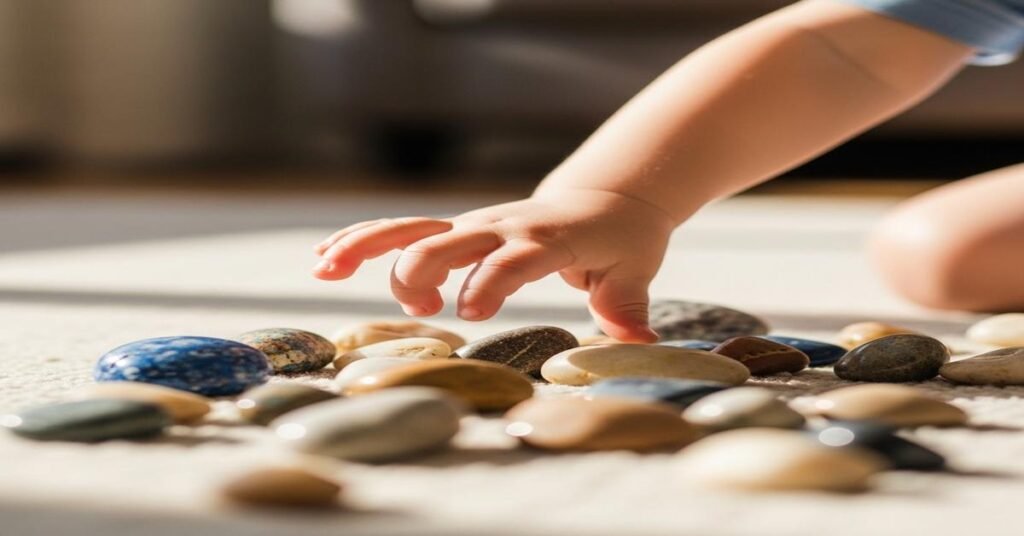Choosing a first stone for a child means balancing meaning and safety. Parents often want a keepsake but don’t always account for choking, allergic reactions, or settings that snag during play. Below I explain which stones, metals, sizes, and settings reduce hazards, and I give age-specific, practical picks you can buy or request from a jeweler.
Why size and setting matter
Stones that are too small or glued in place are the two biggest physical risks. A stone that detaches becomes a choking hazard; anything that fits through a toilet-paper tube or paper-towel roll can be swallowed. That’s why both stone diameter (in mm) and how it’s set are crucial. For reference, a 3 mm round stone is roughly 0.10 carat; 4 mm is about 0.25 ct; 5 mm is about 0.50 ct. Smaller stones under 3 mm can be easier to lose and more likely to be inhaled or swallowed if they fall out.
Best metals for sensitive skin
Allergic contact dermatitis from nickel is common. Metals and typical compositions to prefer:
- 14k gold — about 58.3% gold and 41.7% alloy (usually copper and silver). Lower nickel risk than many base metals, and durable enough for daily wear.
- 18k gold — 75% gold, softer but more inert; good for very sensitive skin if you accept more wear.
- Platinum — nearly nickel-free and very inert, but expensive and heavy.
- Commercially pure titanium (CP Grade 2) — highly hypoallergenic, lightweight, and strong. Avoid Ti-6Al-4V if you specifically want the absolute lowest alloy exposure; CP titanium is gentler for sensitive kids.
- Niobium — inert and hypoallergenic; useful for studs and custom pieces.
- Surgical stainless steel (316L/316LVM) — commonly used and low nickel release, but some very sensitive people still react.
Avoid plated base metals for long-term pieces. Plating (rhodium, gold) is measured in microns and will wear off; once gone, exposed base metal may cause irritation and faster stone loss.
Stones and materials to prefer or avoid
- Prefer: Diamonds, moissanite, and well-set synthetic gems (lab-grown diamonds). Diamonds and moissanite are hard and resist chipping, so small shards aren’t created when a piece gets knocked.
- Caution: Cubic zirconia (CZ) and some glass stones are softer and more brittle. CZs can fracture into small pieces if knocked; glued CZs are common in low-cost jewelry and the glue can fail.
- Avoid glued-on stones whenever possible. Ask the jeweler if the stone is soldered, bezel-set, or glued. Always choose mechanically set stones (bezel, flush, or secure prong) for kids.
Settings and closures that reduce risk
Low profiles and enclosed settings reduce snagging and stone loss. Consider these options:
- Bezel setting — metal rim encircles the stone. It keeps stones from popping out and has no sharp prongs to catch hair or clothing.
- Flush setting — stone sits inside the metal, fully protected. Best for active kids.
- Screw-back or locking earring backs — harder for a toddler to remove than friction (push) backs. La Pousette-style locking backs are secure for school-age children.
- Breakaway clasps for necklaces — these open under tension and reduce strangulation risk. Avoid permanent or very strong clasps for young children.
- Avoid magnetic clasps for small children — they can attract suddenly and cause pinching or be swallowed if small.
Age-by-age practical picks
- Infants (0–2 years): Generally avoid jewelry while unsupervised. If cultural reasons require earrings, choose 14k gold or CP titanium posts, 2–3 mm bezel-set stones (~0.03–0.10 ct). Use sealed, smooth backs and remove during sleep and bath times.
- Toddlers (2–4 years): Avoid necklaces. For earrings, choose 3 mm bezel studs in 14k gold or titanium with screw or locking backs. Bracelets should be fabric or wide, snug bands without beads that can detach.
- Preschool & early school (5–8 years): Small 3–4 mm bezel or flush studs (0.10–0.25 ct equivalent) with locking backs are appropriate. Necklaces only with a breakaway clasp and tiny pendants (<6 mm). Rings are not recommended due to play and swelling risk.
- Older children & teens (9+ years): They can handle more styles. Still prefer hypoallergenic metals and secure settings. For pierced ears, 4–5 mm studs (~0.25–0.50 ct) in bezel or prong with locking backs work well.
Maintenance and habits that prevent accidents
- Check settings monthly by gently tugging and inspecting for loose stones or bent prongs. Tighten or repair promptly.
- Store children’s jewelry in a single small container so tiny stones don’t get lost and go unnoticed.
- Remove jewelry for sleep, baths, sports, and play. Moisture and rough activity accelerate wear and loss.
- Avoid ultrasonic cleaners on delicate or glued settings. Mild soap, warm water, and a soft brush are safer for routine cleaning.
Buying tips and what to ask the jeweler
Ask these specific questions: “What is the metal composition (14k, 18k, CP titanium)?” “Is the stone bezel-, flush-, or prong-set, or glued?” “Are the earring backs screw or locking type?” and “Can you solder the setting to reinforce it?” Request mm measurements of the stone and the carat weight or an approximate conversion. A reputable jeweler will be able to describe the setting and the alloy composition and will recommend a low-profile option for children.
In short: avoid glued stones, choose hypoallergenic metals, prefer bezel or flush settings, and keep stone diameter in the 3–4 mm range for most young children. These choices reduce choking, allergic reactions, and wear — and keep the piece wearable as a safe keepsake for years.
I am G S Sachin, a gemologist with a Diploma in Polished Diamond Grading from KGK Academy, Jaipur. I love writing about jewelry, gems, and diamonds, and I share simple, honest reviews and easy buying tips on JewellersReviews.com to help you choose pieces you’ll love with confidence.

